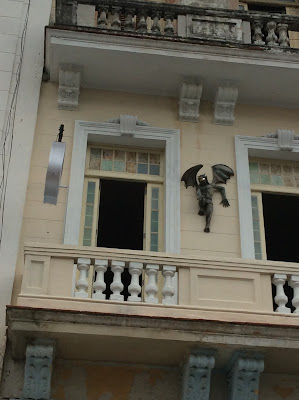March 5, 2016
Our days together may be running short, my artist friend is going back to Canada soon, it will be lonely here without her. Today we roamed around old Havana enjoying the Art scene and meeting some of the artists. this was an intriguing gallery name
I love what his art says.
I too feel like a King snuggled in to my friends art pack
observing the world through her eyes.
We stopped for coffee at the Plaza of Angeles, one of our favorite stops
on we rumbled around town and took a few shots of the world as we saw it and as other artists saw it.
a castle made of old espresso pots at the Museo Nacional de Bellas Artes de La Habana
this was a pottery tower made of reclaimed and imperfect pottery bits in a pottery gallery\ pizzaria called La Cabina
the Gargoyl Casa, his eyes glowed and sent tremors of fear throughout my body, I hid so he could not see me
amazing (even to me) this sculpture of titanium and steel
This was one of the eclectic pieces at the gallery of Leo D'Lazaro
OH NO another beasty! , but at least he is sleeping
This expresses the impact of Art on the Cuban society, Big and Bold
a bit of dancing before going out to the FAC (Fabrica de Arte Cubano) this Saturday night,

 |
Fabrica de Arte CubanoThose going to the Factory have access to musicians, painters and dancers... this is living culture being produced right there and then. However the most important thing is that we have managed to get artists from different manifestations to get closer to each other and to their audiences and for audiences to get closer to the art work.
The factory of art (F.A.C.) is an artistic project that is driven by the need to rescue, support and promote the work of thousands of Cuban artists of all art branches such as: cinema, music, dance, theater, visual arts, literature, photography, fashion, graphic design and architecture; that, through its integration, art/artist promote exchange and direct approach to the public and the creator at mass level.
The building was the ancient utility of Havana, in 1910 to 1930 then became an oil factory "El Cocinero" and later a fishing gear store. Inserted within the community "The fanguito" considered a marginal area with social problems, the F.A.C. project will have in its concept a high awareness promoting full integration with this community and developing community projects mainly in the vulnerable groups that are children and adolescents.
ART
|



REFRESHMENTS
FASHION
A GATHERING OF FRIENDS
My friend returned late at night full of inspiration and excitement of the Cuban cultural scene, it made me proud to be a Cuban


















































